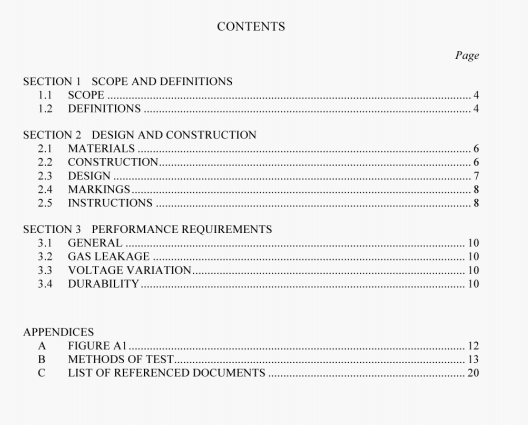AS 4630:2005 pdf – Leakage detection systems.
2.1 MATERIALS
2.1.1 Continuity of satisfactory operation
Materials used in the construction shall be such that continuity of satisfactory operation can be expected during normal usage within the manufacturer’s specification.
2.1.2 Suitability of materials for conditions of use
Materials and finishes. including dressings and lubricants, used in the construction, shall be suitable for the conditions of use (e.g. corrosion. temperature. handling. etc.).
2.1.3 Materials in contact with gas
Materials in contact with the gas. including lubricants, dressings and jointing compounds. shall be suitable for use ith all gases.
2.1.4 Melting point of materials
The valve body(s) shall be made of materials with a melting point not less than 430°C.
2.1.5 Brass parts
Brass parts shall be resistant to stress-corrosion cracking % hen tested in accordance with
AS 2136.
2.1.6 Component parts materials selected to appropriate Standards
Alloys used for component parts shall he selected from appropriate Australian Standards or their equivalent.
2.2 CONSTRUCTION
2.2.1 Continuity of satisfactory operation
Construction shall ensure the continued safe operation of the unit during usage within the manufacturer’s specification.
2.2.2 Castings and hot pressings
All castings and hot pressings shall be clean and sound. free from laps, blow holes and pitting and all surfaces not machine finished shall be clean, smooth and free from sand.
2.2.3 Sealing of porous castings or cracks
Porous castings or cracks in gas-carrying parts shall not be sealed other than by an accepted method for the impregnation of castings, e.g. vacuum impregnation.
2.2.4 Assembled deice to he clean
The assembled system shall not contain dirt. casting sand, swarf or other foreign matter. There shall be no excess diaphragm dressing or jointing compound in the components.
2.2.5 Accidental displacement of parts
Every part shall he secure against accidental displacement and shall be constructed to maintain a fixed relationship between essential parts under normal and reasonable conditions of handling and usage to ensure continued compliance ith this Standard.
2.2.6 Prevention of accidental shift after calibration
Means provided for factory calibration shall be factory sealed to prevent accidental shifting after calibration.
2.2.9 Self-tapping screws
Self-tapping screws, other than those that form a fully swaged machine type thread, shall not be used to secure together the external joint of a gas-carrying component that may be removed in servicing. The application of self-forming screws shall he limited to malleable materials and shall not result in deformation or cracking of the component.
2.2.10 Construction of parts not covered by this Standard
The construction of parts not covered by this Standard shall be in accordance with reasonable concepts of safety. substantiality and durability. The general assembly shall he of a neat and workmanlike character with all parts well fitted.
2.3 I)FSIGN
2.3.1 Fail-safe type
All safety functions shall be of the fail-safe type
2.3.2 Safety device cannot he (nerridden
No safety function shall incorporate the means to bypass or hold open or partly open the function when it should be closed.
2.3.3 Adjusting device
If a leakage detection system is adjustable in the field, stops or equivalent means shall be provided for limiting the adjustments to values covered by the instructions.
2.3.4 Accessibility of integral parts
Integral parts that may require adjustment shall be accessible for adjustment.
2.3.5 Adjusting device
Adjusting devices shall be arranged to prevent movement other than manual adjustment.
AS 4630:2005 pdf – Leakage detection systems
